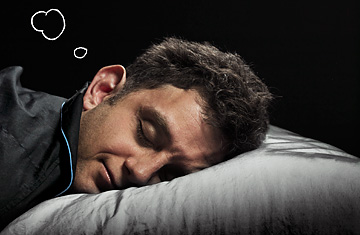
Sleep, as ancient maps once labeled uncharted territories, is where the dragons be. The human brain is a loud and messy and stormy place. We spend our days in a sensory typhoon, buffeted by sights and sounds and experiences, and all that time the brain's prefrontal cortex keeps order: focus here, tend to that, ignore the rest. But at night, the prefrontal punches out--and the crazy begins to stir.
To go to sleep is to enter a world entirely like our own and entirely unlike it too. You can board a plane that's really a car that flies to Russia, except it's the moon and your mom is there--until she's your dad. Dreams can be prosaic or repetitive--exactly how many times can you show up at the same party in your underwear before you remember to put something on?--but whatever they are, they remain mysterious. The sleeping brain runs its absurdist-movie loop all night long, always taking care to conceal what's behind it.
No longer. Neuroscientists have a growing arsenal of tools--fMRIs, PET scans, high-density EEGs--to watch the nocturnal brain at work and see how it ticks throughout the sleep cycle. To the surprise and delight of researchers, that's finally helping explain one of the mind's most ineffable qualities: creativity.
We've all slept on a problem and had it sort itself out by morning. But that's only a small part of what the brain on nighttime autopilot can do. Paul McCartney famously said that he came up with the melody for "Yesterday" in a dream; Elias Howe, the inventor of the sewing machine, is said to have solved the problem of the machine's needle when he dreamed of an attack by warriors carrying spears with holes in the tips. "Dreams are just thinking in a different biochemical state," says Harvard University psychologist Deirdre Barrett, author of The Committee of Sleep. "In the sleep state, the brain thinks much more visually and intuitively."
The hunt for the source of human creativity has been going on as long as people have been creating. It's helping drive the success of the best seller Imagine: How Creativity Works, by journalist Jonah Lehrer. It drives all of us to wonder how celebrated inventors came up with ideas that became the next big thing. And it drives us to wonder how we'll find our own next brainstorm when we need it. It's no secret that sleep can be a well of good ideas--what we're leaning now is how to dip into it.
You, Uncensored
The act of sleeping, as researchers have long known, is a lot more complicated than just conking out for the night. There are two principal cycles of sleep: rapid eye movement (REM) and nonrapid eye movement (NREM), and they alternate throughout the night. Eye movement is only a fraction of what defines the two phases. NREM sleep starts as a light doze--sleep at no greater than snorkeling depth--and steadily progresses to deeper levels in which muscles relax, heart rate and respiration slow and body temperature drops.
